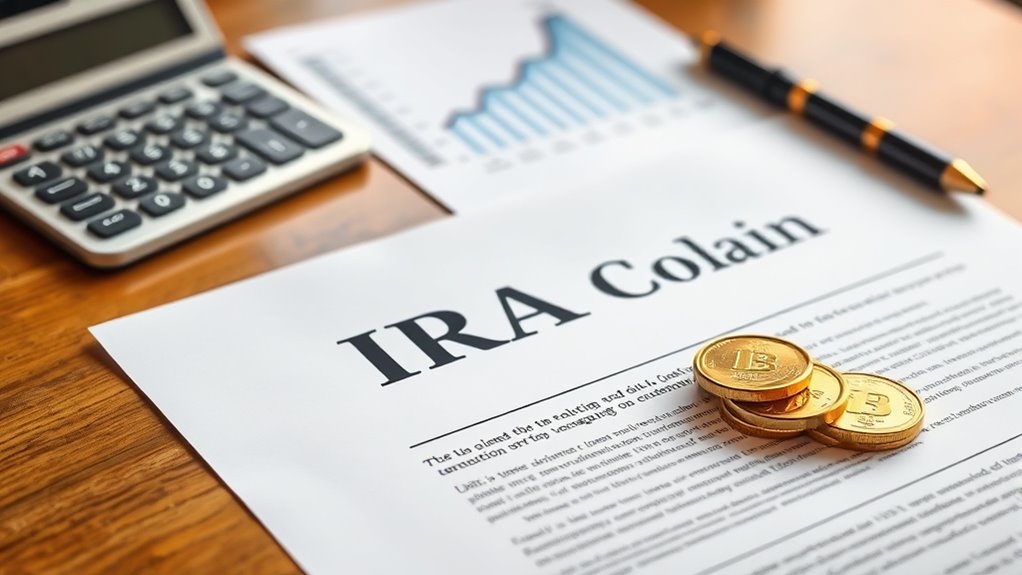The SECURE Act 2.0 brings big changes that affect your Gold IRA strategy. You can now contribute more with higher limits on 401(k), IRA, and other plans, helping grow your gold investments faster. RMDs are pushed back, giving you more time for tax-deferred growth. Plus, more part-time workers will have access to employer-sponsored plans, opening new avenues for funding your Gold IRA. To discover how these updates can benefit your retirement plan, keep exploring the details.

The SECURE Act 2.0 introduces significant changes that can impact your retirement planning, especially if you have a Gold IRA. One of the most notable updates is the increase in the age for Required Minimum Distributions (RMDs). Starting in 2023, you’ll no longer be required to start taking RMDs at age 72; instead, the age has been raised to 73. This delay allows you to keep your Gold IRA funds invested for a longer period, giving your precious metals more time to potentially grow tax-deferred. The change is scheduled to extend further, with RMDs increasing to age 75 by 2033. If you’re approaching 73 in 2025, note the April 1 deadline for your initial RMD, which affects your planning. Postponing distributions can help you manage your taxable income more efficiently, especially since Gold IRAs, often composed of physical assets, can have unique tax implications. The staggered RMD age shifts impact your cash flow strategies, giving you more flexibility in retirement. The RMD rules are designed to accommodate longer life expectancies, which can be advantageous for retirees seeking to maximize their investment growth. Another key change is the increase in catch-up contribution limits for those aged 60 to 63. In 2025, you can contribute up to $11,250 to your 401(k), 403(b), or 457 plans—an increase from previous limits. For SIMPLE IRAs, catch-up contributions jump from $3,500 to $5,250, allowing a total contribution of $21,750. These higher limits enable you to boost your tax-deferred savings during your peak earning years, which can be directed toward your Gold IRA investments. With greater contribution capacity, you have more opportunity to diversify your retirement portfolio and strengthen its resilience. These higher contributions can also provide additional tax advantages, especially since Gold IRAs often benefit from specific IRS rules regarding contributions and growth. SECURE 2.0 also expands access to retirement savings for part-time workers. Starting in 2025, more part-time employees will become eligible to participate in 401(k) plans, broadening the pool of workers saving for retirement. This change can lead to increased inflows into Gold IRAs via employer-sponsored plans, especially for those who previously lacked access. It supports broader retirement readiness and diversification, making it easier to include precious metals as part of your retirement strategy. Additionally, the contribution limits for traditional IRAs have increased to $7,000 in 2025, with a $1,000 catch-up for those aged 50 or older, totaling $8,000. Income phase-out ranges for deductible traditional IRA contributions have also been adjusted, influencing how you plan your IRA contributions and asset allocations, including Gold IRAs. Understanding these regulatory changes can help you optimize your retirement savings approach. Finally, SECURE 2.0 encourages higher employer contributions. Some small businesses may increase matching or non-elective contributions, providing you with additional savings options. Overall, these changes aim to enhance your retirement security by offering more flexibility, higher contribution limits, and broader access—benefiting your Gold IRA strategy through increased opportunities for growth, diversification, and tax efficiency.
Frequently Asked Questions
How Does SECURE Act 2.0 Affect Early Withdrawal Penalties for Gold IRAS?
You should know that early withdrawals from your Gold IRA before age 59½ generally face a 10% IRS penalty and applicable taxes. However, SECURE Act 2.0 expands some penalty exceptions, like for disasters or medical expenses, giving you more options to access funds penalty-free in certain situations. Despite this, you’ll still owe taxes on traditional IRA distributions, so plan your withdrawals carefully to minimize costs.
Are There New Contribution Limits for Gold IRAS Under SECURE Act 2.0?
You’re wondering if there are new contribution limits for Gold IRAs. Currently, the contribution limits stay consistent with traditional IRAs: $7,000 for those under 50 and $8,000 for those 50 or older, including catch-up contributions. Gold IRAs follow these same rules, and the limits are based on your total IRA contributions across all accounts. No special limits or increases apply specifically to Gold IRAs at this time.
What Tax Benefits Are Available for Gold IRA Investors Post-Secure Act 2.0?
You benefit from tax-deferred growth with your Gold IRA, allowing your assets to appreciate without immediate taxes. Traditional IRAs let you deduct contributions, reducing your taxable income, while Roth IRAs let you contribute after-tax dollars, offering tax-free withdrawals in retirement. Although the SECURE 2.0 Act doesn’t directly change gold’s tax treatment, these general IRA benefits remain. Consult your financial advisor to maximize your tax advantages and align your strategy with your goals.
Does SECURE Act 2.0 Change the Eligibility Age for Gold IRA Distributions?
You might think the eligibility age for Gold IRA distributions is set in stone, but guess what? SECURE Act 2.0 dramatically shifts the game, raising the age to start distributions from 72 to 73 in 2023, and then to 75 in 2033. This means you get more time to grow your gold assets tax-deferred, offering you even greater control and flexibility over your golden retirement treasure!
How Might SECURE Act 2.0 Influence the Future of Precious Metals Retirement Investing?
You might wonder how future precious metals retirement investing will evolve. With the recent changes, you’ll have more flexibility, like increased contribution limits and a higher RMD age, giving you extra time to grow your assets tax-deferred. These updates could make investing in gold and silver more attractive, helping you diversify and hedge against inflation. Overall, you’ll find more options and better strategies for securing your retirement with precious metals.
Conclusion
While some worry that SECURE Act 2.0 might limit your gold IRA options, rest assured it actually enhances your retirement planning flexibility. By increasing contribution limits and offering new incentives, it encourages smarter, more diversified investments. Don’t let concerns hold you back—embrace these changes to strengthen your financial future. With a well-informed approach, you can confidently navigate the new landscape and secure your retirement goals with your gold IRA.









